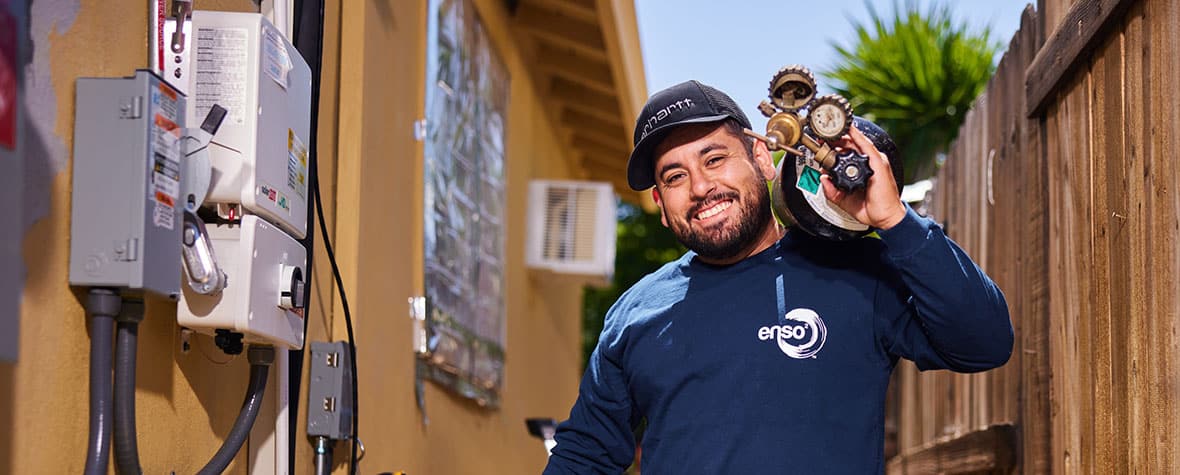California es el hogar de una economía diversa impulsada por una gran variedad de industrias, como el transporte marítimo, la construcción y el turismo. En esta octava entrega de nuestro Potenciar la electrificación exploramos cómo la electrificación de estas industrias es una estrategia clave para reducir las emisiones e impulsar avances significativos hacia un futuro más limpio y sostenible. En 2021, las emisiones del sector industrial contribuyeron 19.6% de las emisiones totales de GEI de California.
Sustituir los equipos y procesos que funcionan con combustibles fósiles por alternativas eléctricas alimentadas por energías renovables es esencial para reducir las emisiones y combatir el cambio climático. Esta transición está en consonancia con los objetivos estatales de alcanzar una red de energía limpia de 100% en 2045.
Las emisiones del sector industrial proceden principalmente de las fuentes de combustión de combustibles, incluidas las refinerías, la producción de petróleo y gas y las cementeras, así como de las empresas que dependen de ellas, como el transporte, los puertos y la construcción.
Puertos
Electrizante puertos como Oakland y Richmond es fundamental para mejorar la calidad del aire y la eficiencia del transporte de mercancías en la zona de la bahía. Estos puertos están recibiendo financiación para transformar los equipos de carga diésel en alternativas de emisiones cero, modernizar los servicios públicos y mejorar la infraestructura eléctrica. El objetivo es transformar los puertos de California en centros económicos sostenibles y respetuosos con el medio ambiente.
Construcción
El sector de la construcción de California está avanzando en la electrificación para reducir las emisiones y mejorar la sostenibilidad, por ejemplo sustituyendo los equipos diésel por alternativas eléctricas como excavadoras, grúas y carretillas elevadoras alimentadas por baterías. Estos cambios reducen las emisiones de gases de efecto invernadero y la contaminación acústica, al tiempo que mejoran la calidad del aire.
Estado normativa exigen ahora que las nuevas viviendas incluyan electrodomésticos y sistemas solares en los tejados, lo que acelera la transición a la energía limpia. Además, los edificios están adoptando diseños totalmente eléctricos para la calefacción, la refrigeración y el calentamiento del agua, con el apoyo de códigos y normas actualizados. incentivos.
Turismo
El próspero sector turístico de California está cambiando el transporte a gasolina por opciones eléctricas más ecológicas. Los visitantes ya pueden disfrutar del transporte eléctrico para hacer turismo en destinos emblemáticos como Napa y San Francisco. Disneylandia tiene previsto electrificar los coches en miniatura diésel de su atracción Autopia, en consonancia con el impulso del Estado hacia la sostenibilidad. Bicicletas eléctricas se están convirtiendo en una opción popular y ecológica para explorar, ya sea a través de visitas guiadas por la naturaleza o del alquiler público de bicicletas.
Mientras tanto, la expansión de las estaciones de recarga de VE proporciona más comodidad a los conductores de VE para aliviar la ansiedad por la autonomía. Al electrificar el turismo, California protege sus recursos naturales tanto para residentes como para visitantes.
Plantilla
Para llevar a cabo todos estos esfuerzos de electrificación es esencial contar con una mano de obra bien informada y cualificada. A medida que se expanden las tecnologías de energías limpias, sigue creciendo la demanda de profesionales cualificados para diseñar, implantar y mantener estos sistemas. Los trabajadores deben tener experiencia en áreas clave como la infraestructura de vehículos eléctricos, los sistemas de edificios energéticamente eficientes, los equipos portuarios electrificados y las herramientas agrícolas alimentadas por energías renovables.
Los programas de formación se centran en competencias como la instalación de cargadores de vehículos eléctricos, el mantenimiento de flotas de transporte eléctrico, la adaptación de edificios a sistemas totalmente eléctricos y la integración de tecnologías solares y de almacenamiento en baterías. Al invertir en estos programasCon la electrificación, garantizamos el éxito de la electrificación al tiempo que creamos oportunidades significativas para los trabajadores de la economía verde.
La contribución del Área de la Bahía
Regiones como el Área de la Bahía avanzan en la electrificación industrial y la formación de la mano de obra, y ponen de relieve el potencial de la electrificación para transformar industrias en todo el mundo. Hitos como lograr 100% de electricidad renovable para más de 100 días demuestran que los ambiciosos objetivos climáticos están al alcance de la mano. A través de la innovación, la colaboración y la inversión en energías limpias, la electrificación está demostrando ser una vía alcanzable hacia un futuro sostenible y resiliente.




